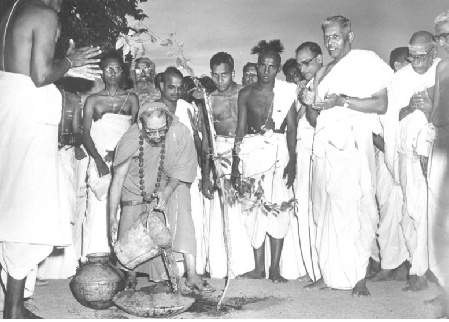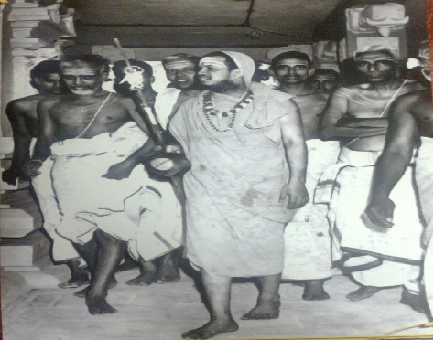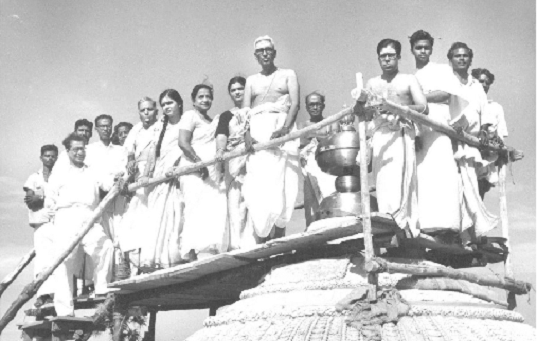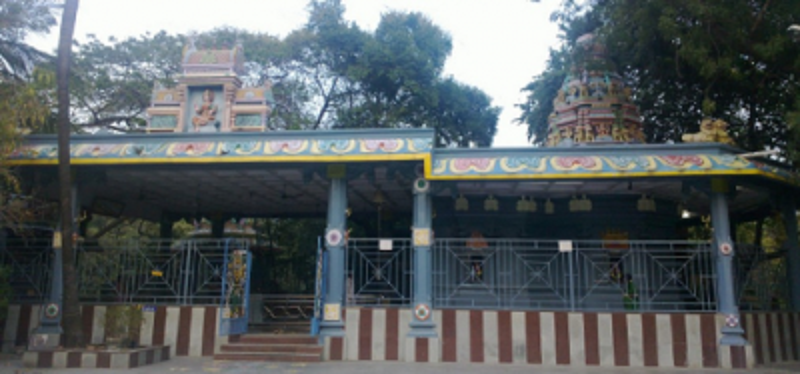This essay is jointly authored by the following writers hailing from Indian Institute of Technology, Madras:
Arun Ayyar: Alumnus of Department of Electrical Engg, Indian Institute of Technology Madras
Harish Ganapathy: Department of Metallurgical and Materials Engg., Indian Institute of Technology Madras
Hemanth C: Department of Electrical Engg., Indian Institute of Technology Madras, Chennai-600036
INTRODUCTION
Indian Institute of Technology Madras (IITM) was commissioned in 1957. There are three temples inside the IITM campus:
- Sri Jalakantheswara temple on the Delhi Avenue
- Sri Peeliamman Temple on the Delhi Avenue near the stadium
- Sri Varasidhdhi Vinayaka Temple behind Taramani Guest House.
These deities have been much before IITM was established. However, no written record of these temples is available with the temples regarding their history in the pre-IITM period. To reconstruct the history of these temples, informal interviews were conducted with the people connected to the area before and during the establishment of IITM. In order to gain the archaeological view point we sought the help of Dr. Nagaswamy, a renowned archaeologist and epigraphist. He served as the Director of Archaeology of Tamil Nadu state Government for 22years. This document is a summary of the findings of this exercise.
SRI JALAKANTHESWARA TEMPLE
The Jalakantheswara temple is located near the main gate of IITM on the Delhi Avenue. The main deity in this temple is Lord Shiva worshipped as Jalakantheswara along with his consort Devi Katyayani.
Prior to the establishment of IITM, the Shiva linga was present under a mandapam with a thatched roof near the IITM lake area and was awe-inspiring by its size. Residents of the nearby villages offered daily worship to the Shiva lingam.
During the establishment of IITM, the residents of IITM approached Mahaperiyavaa(Kanchi Kamakoti Peethadhipathi Jagadguru Sri Chandrasekharendra Saraswathi Swamiji) about the procedure to be followed for worshipping the linga. He told them to construct a temple and continue the puja.
When the question of naming the Lord arose, Mahaperiyavaa told them that there was no need to give a new name to the lingam since it had been previously worshipped by Appaya Deekshitar.
Appaya Deekshitar (1520-1593) was an Advaita Vedanta scholar who composed the famous Margabandhu Stotram and Atmarpana stuti.
Mahaperiyavaa told them that the lingam had been previously worshipped as “Jalakantheswara”. He also directed them to check the documents available in the nearby Raj Bhavan for further details.
According to the information furnished by the Controller of Raj Bhavan area in 1959, the precincts of the temple had formed the route from an ancient place of worship in Vedashreni (present Velachery) to Thiruvanmiyur and had been frequented by great saints including Appaya Deekshitar.
During a recent visit to Kanchipuram, Balaperiyavaa (Kanchi Kamakoti Peethadhipathi Jagadguru Sri Shankara Vijayendra Saraswathi Swamiji) mentioned that the then king performed the Shastiabdapurthi (60th birthday) of Appaya Deekshitar in the temple where the Jalakantheshwara lingam had been present.
The construction of the present Jalakantheswara temple started around 1962 and was finished in 1965. The Vimana Kalasam of Sri Jalakantheswara weighs about 300 kg. The first Kumbhabhishekam of the Sri Jalakantheswara temple was performed on18 June, 1965 in the holy presence of Puduperiyavaa (Kanchi Kamakoti Peethadhipathi Jagadguru Sri Jayendra SaraswatiSwamiji).
Sringeri Sharada Peethadhipati Sri Abhinava Vidyatheertha Swamiji visited the temple on 7 November, 1965, whileMahaperiyavaa himself visited the temple on 20 February, 1966.
Based on the information available, the lingam is at least 400 years old.
In the souvenir printed about the Sri Jalakantheswara temple kumbhabhishekam in 1986, the following text is present. The story of the lingam, summarized from the reading of the Kakabujander Nadi which was with the Raj Bhavan authorities is as follows:
“There was a Gandharva Kumaran by name of Vanavilangan. While he was passing through the sky, he spotted a lovely lake with a charming swan on it. He attempted to capture and take the swan away but as the swan was goddess “Kali” herself, she cursed Vanavilangan that he would become a stone. The gandharva kumaran accepted the punishment but prayed to the Goddess for redemption. The Goddess relented and commanded him to build a temple and perform penance as a stone, until he was redeemed by the touch of holy feet of Thrikala Gnanis and saints. Comforted by this blessing of the Goddess, he built a temple where goddess rested and established a shivalingam at the foot of which he lays as a stone for ages, until he regained his original form. The lingam was shifted as years passed, and once a king(hunter) attained salvation by spotting it. Finally a Brahmin Yogi with great efforts lifted the lingam and planted at the bank of the lake, where it was subsequently found in 1959. Then adi describes the shivalingam as a composite whole, fusing Lord Jalakantheswara and Devi Katyayani as one cognate expression of universal peace ,prosperity and glory.”
The following photographs were taken from souvenir printed during the Kumbhabhishekam of Sri Jalakanteswara temple conducted in 1986. We have included the other photographs in the Photo Gallery section at the end.

Kumbhabhishekam to Jalakantheswara temple vimanam in the presence of Puduperiyavaa.The vimanakalasam weighs about 300kg. Also seen in photograph is ProfKrishnamurty.

Jagadguru Sri Abhinava Vidyatheertha Swamiji of Sringeri Sharadapeetham visiting Sri Jalakantheswara temple on 07 Nov 1965.

Maha periyavaa visiting Sri Jalakantheswara temple on 20 Feb 1966. Also seen in photograph Prof Krishnamurty, Sri Y.S.Ramaswamy and Sri T.R.Rajagopal.(Courtesy IITM Heritage center)
SRI DURGA PEELIAMMMAN TEMPLE
This temple is located on the Delhi avenue near the stadium. The main deity in this temple is Goddess Durga Peeliamman who is worshipped as the grama devata/yellai amman (the Protecting Goddess of the area). Before the establishment of IITM, there was a small Devi idol which was worshipped as a benevolent goddess as opposed to the usual fierce form associated with any yellai amman.
Sri Durga Peeliamman temple
The people we spoke to mentioned an interesting ritual where people with health problems used to undertake once they were cured of the disease after praying to Goddess Peeliamman. The ritual was called “Kodaikalyanam”. The afflicted person would take a shakthi karagam (pot filled with water) on their head and go around the boundaries of other villages which were near Taramani.
The journey would start from Sri Durga Peeliamman temple and pass through Thiruvanmiyur, Kottivakkam, Perungudi, Narayanapuram, Puzhidivakkam, Velachery, and other villages and finally end at Sri Durga Peeliamman temple. The person would visit the grama devata temples of each of these villages before returning back to Sri Durga Peeliamman temple.
It was believed that if a person with health problems would pray that they would perform this ritual, then it would cure the person of their health problems. The exact route taken in those days would be different from the one shown since we could not locate the gramadevata temples of the respective villages.
SRI VARASIDHDHIVINAYAKATEMPLE
Sri Varasidhdhi Vinayaka temple is situated in the hostel zone behind Taramani Guesthouse. The main deity in this temple is the Varsidhdhi Vinayaka or Ganesha. The temple also houses two Shivalingas.
A.Sri Varasidhdhi Vinayaka
The senior citizens whom we spoke to said,”Yenpatennukkupatenkalatuleirunduiruku”. (The Ganesha murti has been around since the time of my grandfather’s grandfather).This easily makes it at least 200yearsold.
B. BhajanaMatamandTulasiMaadam
The people we spoke to mentioned that there was also a matam with a Mahavishnu photo next to the Vinayaka murti where the people used to conduct bhajans in the month of Margazhi (Dec-15toJan-15).There was also a tulasi maa dam,which can be seen even now. As of today, the bhajana matam does not exist.
C.SriAdipureeshwaraLingam
The svayambhu Shiva Lingam adjacent to Sri Varasidhi Vinayaka is worshippedas Sri Adipureeshwara. The security officer Mr. T N Venkatraman joined IITM in the early days of its establishment in 1959. He resided in the building where the current Taramani Guest House exists. He was also affectionately called as ”Bullet Iyer” since he rode a Royal Enfield Bullet.
In those days, the place next to the Vinayaka murti was full of thorns and dense growth. He found the svayambhu Shiva lingam in the bushes and did the initial pujas.
When Mahaperiyavaa visited the Jalakantheswara temple on 20th February 1966, he also visited this temple and performed pujas to both Sri Varasidhdhi Vinayaka and Sri Adipureeshwara. This information was provided to us by Smt. Shanta Venkatraman (aged 85), wife of the late T. N. Venkatraman. She resides in Adyar.
When we contacted Brahmashri Somu Gurukal, who was the priest at the temple from 1976-2008, and currently serving at Dandeesh waram temple, gave more information about Sri Adipureeshwara.
He told us that Puduperiyavaa visited this temple around 1975-1976. During his visit, Puduperiyavaa kept his dandam on the lingam and went into deep meditation for a few minutes. He then instructed Somu Gurukal to take proper care of Shri Adipureeshwara since the murti is a svayambhu murti and also told him to establish an aavudayar (the supporting stone structure surrounding the lingam). Due to financial constraints at that point of time, Shri Venkatraman provided a temporary cement aavudayar. Somu Gurukal also cites several instances where he found a snake curled around the lingam.
Later in 2000, in order to preserve the deity, a copper kavacham was adorned to it. The kavacham is removed for three days a year starting from the purnima of thethiru karthigai month according to the Tamil almanac. During this period,sambrani oil is applied to it in order to prevent attracting moths, insects, etc.
D.Nandi
In front of the Adipureeshwara Shiva linga is a Nandi. Different views of the Nandi are shown in the following photograph.
From an archaeological viewpoint, Dr. Nagaswamy’s scholarly inputs about the Nandi are very interesting.
According to him, the Nandi was sculpted during the Pallava period, which ended around 850 CE. The Pallava sculptors fashioned the Nandi after a variety of bull called the “Nellore/Ongole Bull.” The specialty of this variety was that the distance from the hump to the tail was larger than that of the other bulls. Also, this variety was characterized bya distinct hump, short ears and small horns. The Nandis sculpted during the Pallava period had the aforementioned characteristics while those sculpted during the later Chola and Pandya periods did not have them. The Nandi is sculpted from laterite stone. It is red in color, but years of abhishekam have turned the color black. Dr. Nagaswamy estimated the Nandi’s age to be at least 1200 years.
E. Sri Kailasanatha Lingam
This Shiva lingam is present behind the Vinayaka Sannidhi. While digging for the foundation of the Ganga hostel, this lingam was found in the ground. The lingam was initially placed behind the CCW office. In 2005, the lingam was shifted to the Vinayaka temple and placed behind the Vinayaka Sannidhi under a Bilva tree.
F. Black Stone behind Nandi
Behind the Nandi,there is a tall black stone about three feet high.
This photograph shows some distinct inscriptions on the stone. Towards the bottom of the stone, three lines can be seen which could possibly represent the symbol of a Trishul (trident).
To read the inscriptions clearly, they had to be transferred on to a paper. This process is called “stone rubbing”. One of the team members had the experience of performing the process while briefly working with Dr. V Vedachalam, a noted epigraphist. The procedure used was as follows:
- Wet unbleached thick paper is put on the stone and beaten with a brush till an impression is formed on the paper.
- A specially prepared dye is then applied gently on the surface. As a result, the depressed region will not be dark.
- The paper is then removed carefully and dried.
The following photograph shows the result after completing the aforementioned procedure. As we notice, the visibility of the inscriptions has improved drastically.
Looking at the imprint, Dr. Nagaswamy concluded that it contains two sets of inscriptions:
- the lower inscription is the older one
- the upper inscription is a later inscription.
He then explained the inscriptions:
- The lower inscription contains a sun, a moon and a sceptre. In addition, it contains two curved lines on the sides.The two curved lines are actually parts of two fishes. Hence, the complete inscription consists of a sun, a moon, a sceptre in the centre and two fishes on the sides. This was the old royal emblem of the Pandya Empire. On stone, the Pandyas used to inscribe the fishes vertically and not horizontally. This emblem might have been engraved in the 12th century.
- The inscription on the top consists of a Bull, the emblem used by the Vijayanagara Empire. This emblem might have been engraved in the 15th century.
- Based on the symbols, Dr. Nagaswamy concluded that the stone might have been a boundary stone used to mark a geographical area like a village. Since the symbols of two different empires are intact, it was likely that the boundary which was drawn during the Pandya reign remained the same during the Vijayanagara reign too.
V. DURGA DEVI VIGRAHA
There is a small vigraha of Sri Durga Devi beneath a banyan tree near the swimming pool. The vigraha is made of black stone.
Dr. Nagaswamy estimates the age of this vigraha to be the same as that of the Nandi present in front of Sri Adipureeshwara shrine—around 1200 years old. He is also of the opinion that the vigraha might be that of one of the Sapta matrukas (Seven Divine Mothers).
MISCELLANEOUS
Consider the following temples:
(a) Sri Dandeeswaram temple in Velachery
(b) Sri Marundeeswarar temple in Thiruvanmiyur
(c) Sri Kapaleeswarar temple in Mylapore and
(d) Karaneeswarar temple in Saidapet.
Some of the devotees we spoke to mention that Sri Jalakan-theswara temple is in line with two of the aforementioned four temples. Some devotees also mentioned thatSri Jalakantheswara temple is at the centroid of the triangle formed by taking three out of the four temples.
In the following graphic, we present the location of all the temples on Google maps. The location of Sri Jalakantheswara temple is “not exactly” on the line joining Sri Marundeeswarar and Sri Karaneeswarar temples nor is it“exactly” on the line joining Sri Kapaleeswarar and Sri Dandeeshwaram temples. The location of Sri Jalakantheswara temple is also not the centroid of any of the triangles.
However, since the Sri Jalakantheswara lingam was found near the lake region, we included a marker in the approximate location, which may seem to be at the centroid of the triangle formed by Sri Karaneeswarar, Sri Marundeeswarar and Sri Dandeeswaram temples.
Map with location of various temples.
SUMMARY
In this article, we have described the rich history of the temples inside the IITM campus. We have also included some rare photographs so that they are preserved for posterity. The Nandi, the black stone in Sri Adipureeshwara temple and the Durga Devi vigraha are pieces of great archaeological importance which should be preserved with great care.
ACKNOWLEDGEMENTS
We are extremely thankful to people in and around the IITM campus who spoke to us, the members of Shri T. N. Venkatraman’s family, Brahmashri. Somu Gurukal, members of Temple Samajam, Sri Gnanasekaran, Sri V. Balasubramanian, Shri Chandrashekaran, and Sri Subramanian for providing us with the necessary information for compiling this document.
Special thanks are due to Shri M. J. Shankar Raman for arranging meetings with Dr. Nagaswamy. We cannot express our gratitude enough to Dr. Nagaswamy for spending his time and giving detailed scholarly explanations. We would like to extend special thanks to Shri D. K . Natarajan, Prof Radhakrishnan, Prof Ajit kumar Kolar and IITM Heritage center for providing us with some rare photos. Finally we would like to thank our friends whose critical comments helped in improving the quality of this document.
REFERENCES
- Granite commemoration stones in the Jalakantheswara temple.
- Sri Jalakantheswara temple Kumbhabhishekam Templesouvenir, 1986.
PHOTO GALLERY
In this section, we present the photographs taken during the visit of some noted personalities such as Sri Abhinava Vidyatheertha Swamiji, Mahaperiyavaa, Puduperiyavaa and Sri Jayachamarajendra Wodeyar Bahadur, Maharaja of Mysore to Sri Jalakantheswara temple.











First published at VIGIL as a PDF. Parts of the essay have been edited for language.
IndiaFacts Staff articles, reports and guest pieces


















